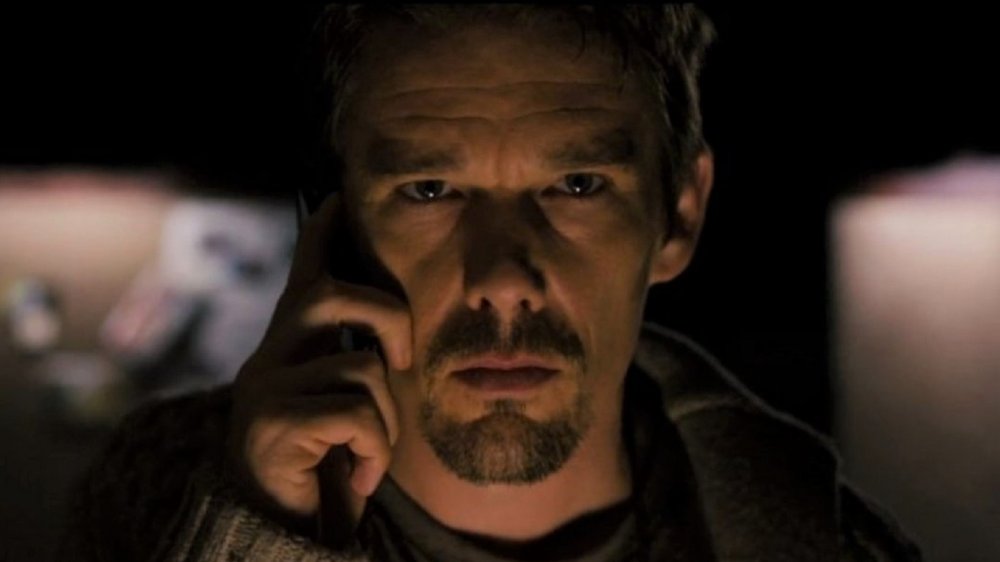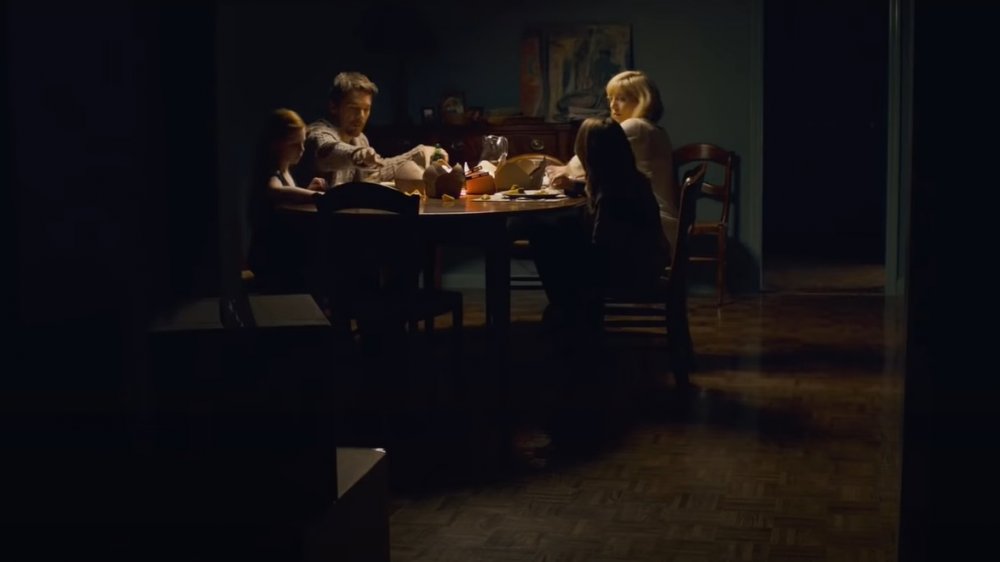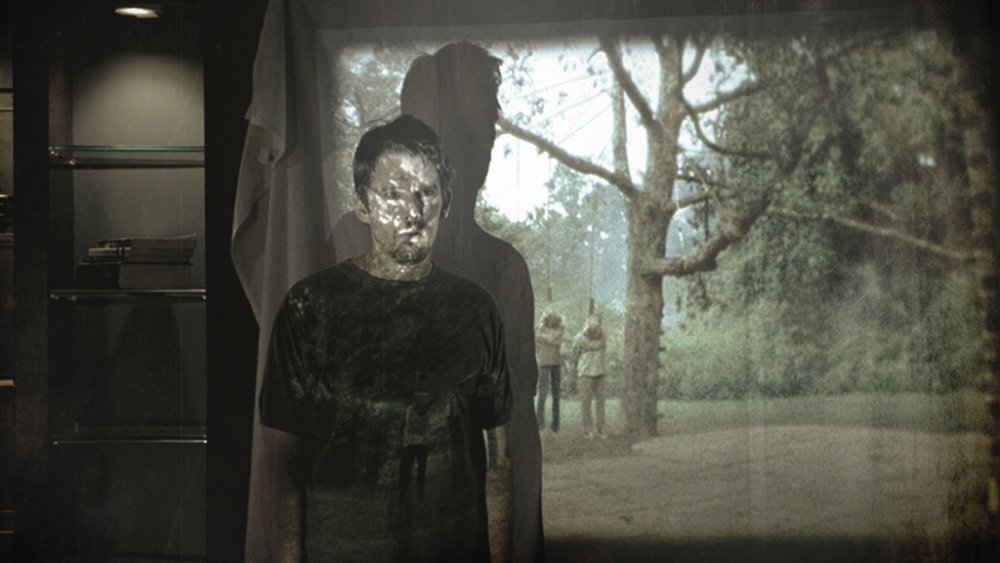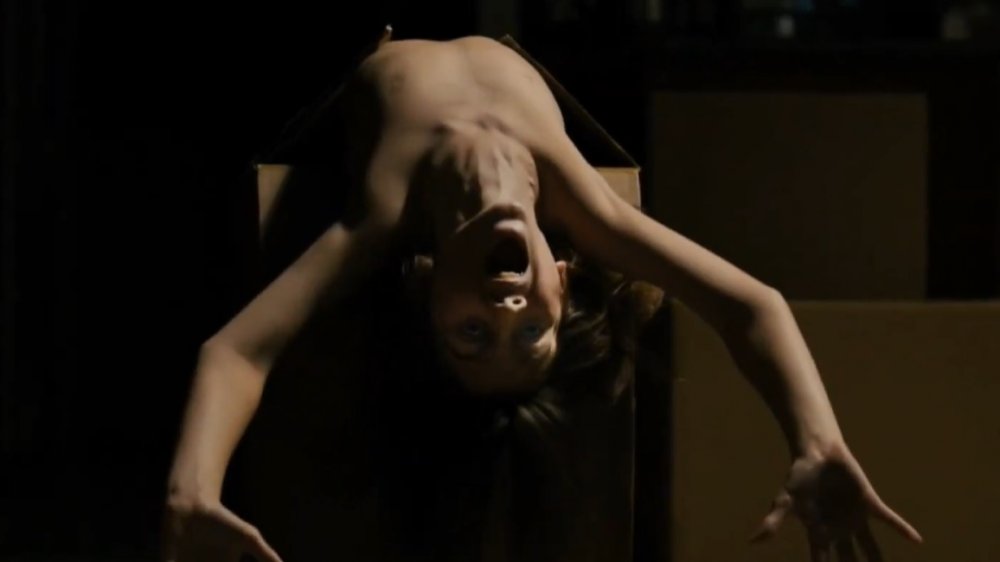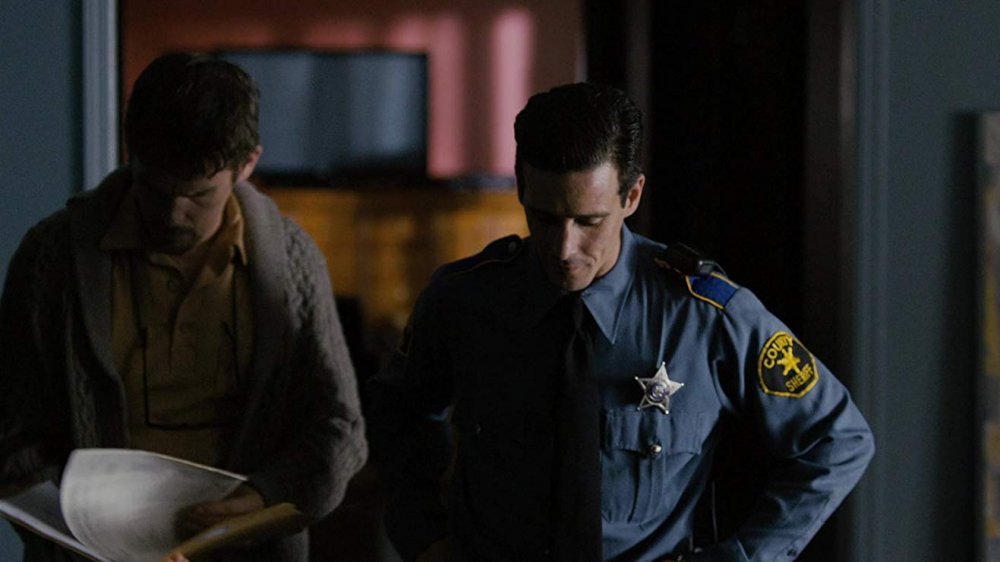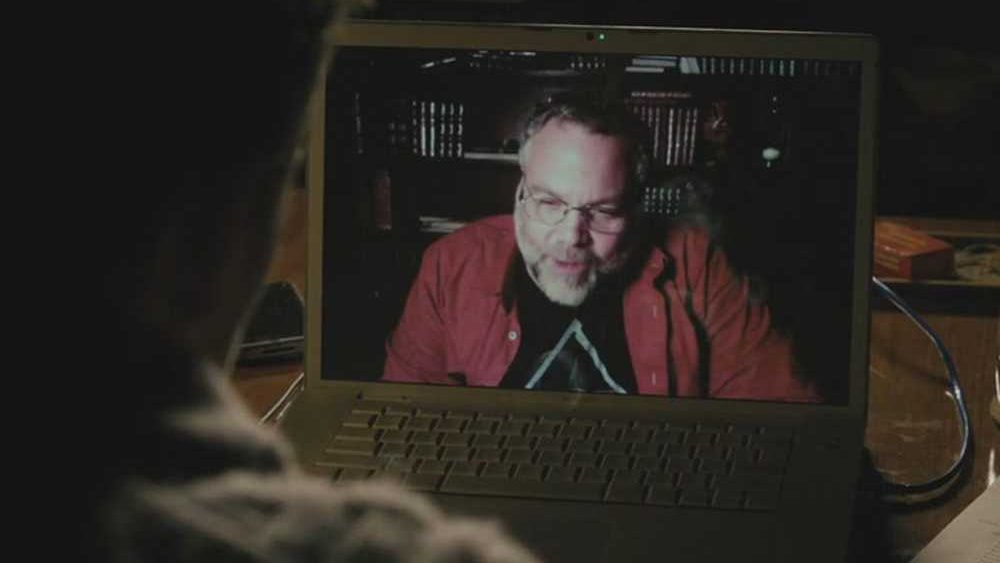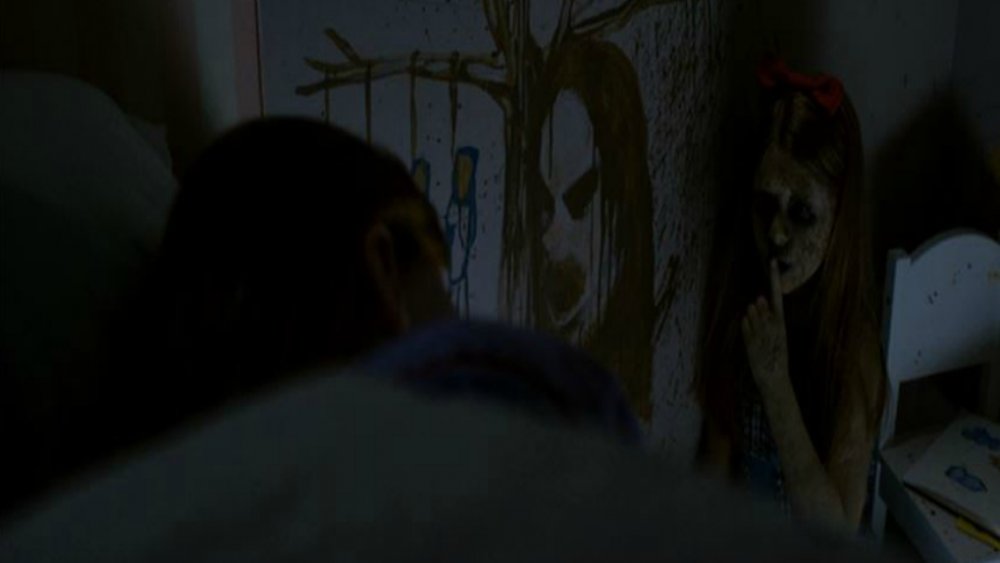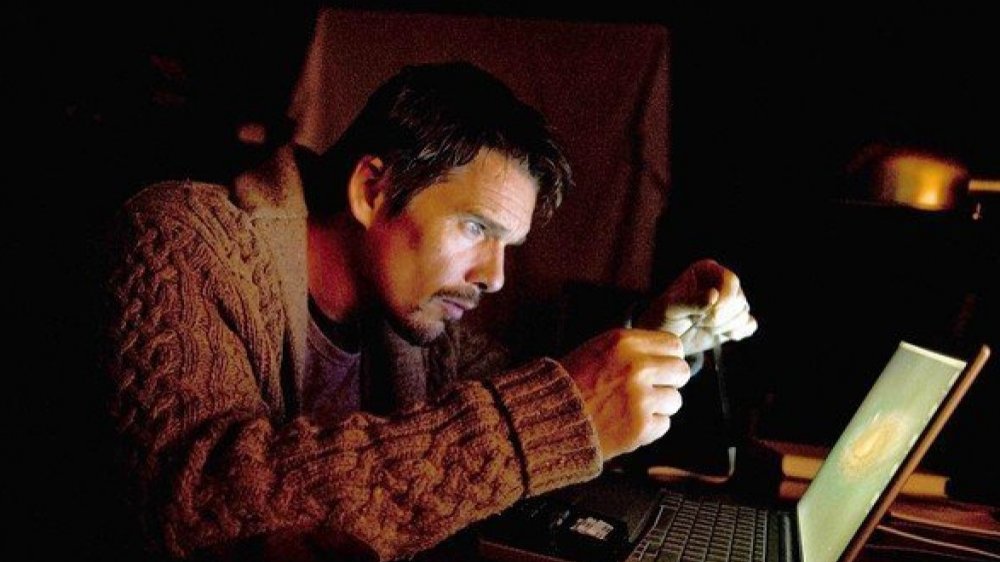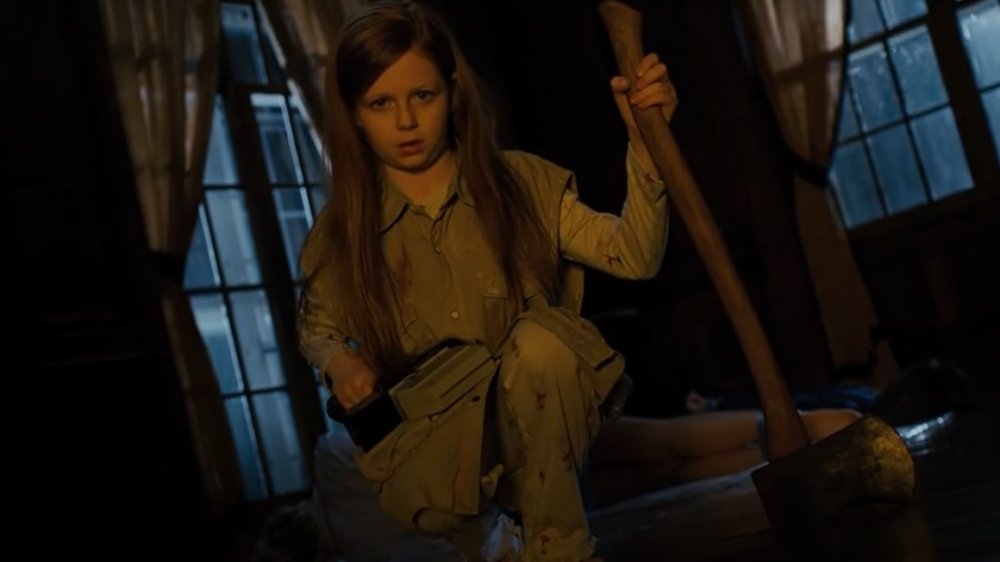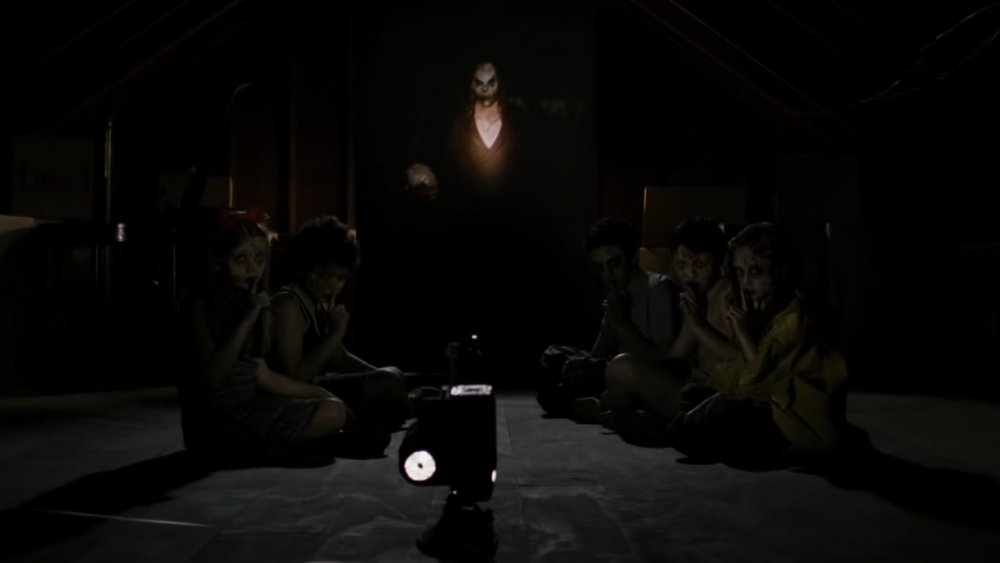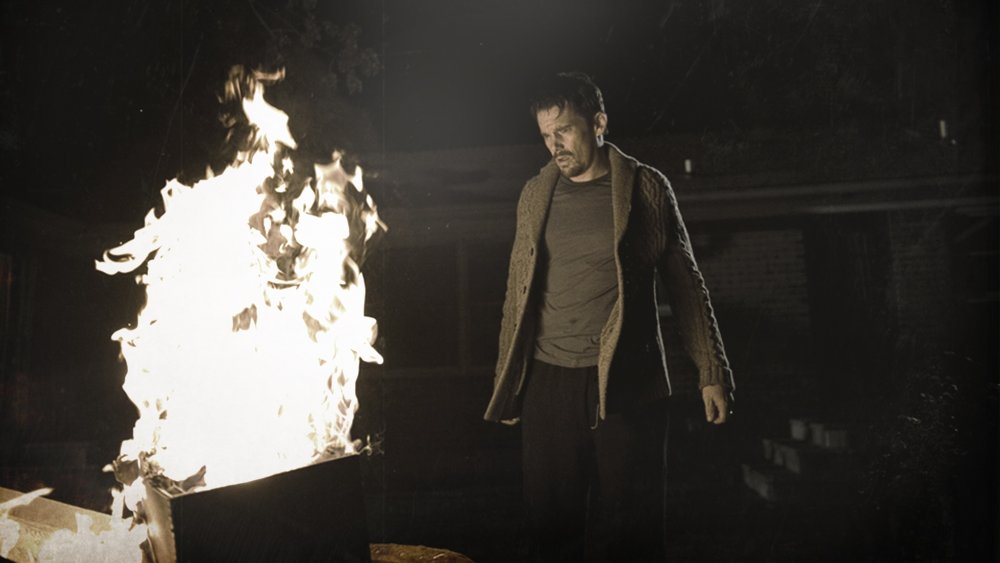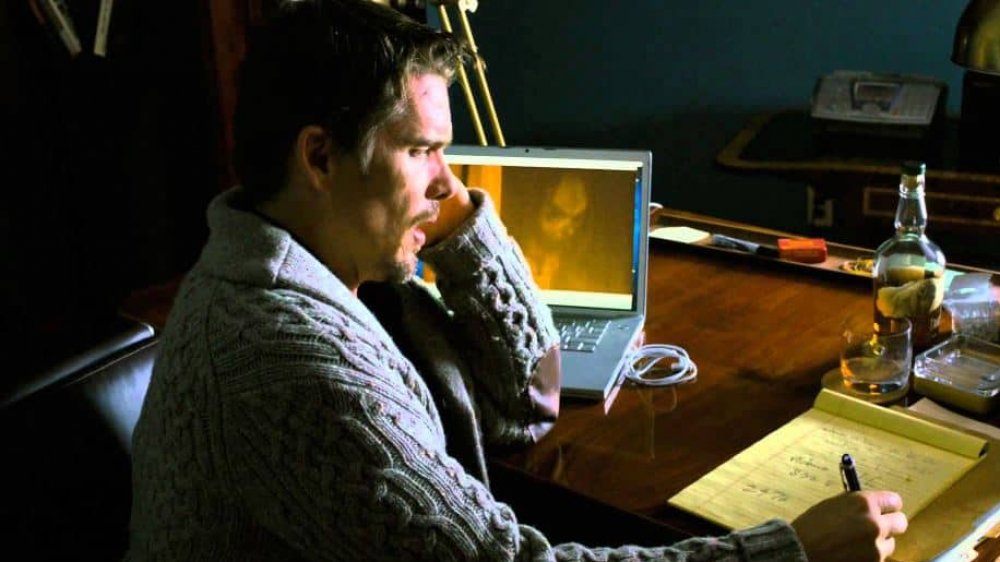The Ending Of Sinister Explained
There's been an ongoing debate since the dawn of the horror fandom about what the actual scariest movie might be, weighing powerful horror movies by a number of factors including critics reviews, box office draw, and personal taste. But science has spoken, and the results are in — Scott Derrickson's 2012 possession slasher drama Sinister has been determined to be the scariest movie of all time. The study measured the heart rates of 50 individuals as they watched a series of 50 horror movies, and participants' hearts were beating literally twice as high as normal during their viewing of the genuinely creepy Sinister, a film that's pushed horror boundaries by making children vicious mass murderers.
While some might disagree with the entire premise of the study — which focused on horror films with huge jump scares that caused heartbeat spikes — Sinister is still indeed a terrifying story, made scarier by its effective use of music, lighting, and Ethan Hawke's moving, three-dimensional portrayal of Ellison Oswalt, a has-been crime writer who has no idea the danger he's put his family in, all for the sake of a new book. And if you want to understand what happens in the film's final grisly moments, then here's the ending of Sinister explained.
The Oswalts move into a murder house
Sinister opens in a chilling tableau. A Super 8 video reel shows a family of four — the Stevensons — noosed to a tree as an unseen figure saws off a branch, lifting the family into the air to painfully struggle and die. And the story remains unrelenting from there on.
Ten years before these murders, Ellison Oswalt had been a wildly successful true crime writer, whose book Kentucky Blood (a clear reference to Truman Capote's seminal true crime novel, In Cold Blood) had hit a cultural zeitgeist. But in the decade since, his work has not only suffered, but he also helped release a killer thanks to his sensational writing style. As Ellison and his family unpack boxes into the new house — the same one we saw in the opening footage — they're under the watchful eye of the local sheriff (Fred Dalton) who thinks Ellison is absolutely sick in the head for not just moving into a crime scene, but bringing his wife Tracy (Juliet Rylance), daughter Ashley (Clare Foley), and son Trevor (Michael Hall D'Addario) with him.
When Tracy sees the cops' very unwelcome presence, she asks Ellison, "We didn't move down the street from another crime scene?" When Ellison goes to explain, she says, "No, just don't say anything. If we did, I don't wanna know about it." Big mistake, Tracy. Ellison's strange daughter, Ashley, is equally far from thrilled to be in the new house, and Tracy says on no uncertain terms that if Ellison's past struggles repeat themselves, she's leaving him and taking the kids. She wants him to go back to writing fiction and textbooks, not these dark dives into human depravity.
Ellison finds the grotesque home movies
Trying to avoid his wife's firm but compassionate ultimatum, Ellison begins setting up his home office as if he were a homicide detective, with boards filled with crime scene photos and threads marking connections. It wasn't just that the four Stevensons were murdered on the tree still standing in the backyard. As it turns out, their daughter, Stephanie (Victoria Lee), went missing, and Ellison is convinced if he can find her, his book would set them up for life.
But as Ellison stores things up in his new attic, he finds a box filled with Super 8 film reels labeled with masking tape. He sets up a makeshift projector screen to watch them, and the first film, marked "Hanging Out," is the footage of the Stevenson family murder in the backyard. An increasingly horrified Ellison watches the terrifying tape all the way through, and by the time it's done, he has two big questions — who made the film, and why would you film it?
As he stares at the terrible tree in his yard, he's badly startled by Ashley wandering around the house, looking for the new bathroom. After tucking her in, Ellison's pours himself a huge glass of bourbon, and his obsession deepens with the second film reel, labeled "Family Fishing," in which a family is bound and chained in a car that's doused with gasoline as someone off-camera throws a lighted match. Ellison is so disturbed that he actually calls his enemies, the police, but he decides the killer must've left the tapes for him so he hangs up. He's about to watch the third tape, "Pool Party," when he hears another noise in the house.
The start of the Oswalts' descent
As Ellison searches his house, thinking it's Ashley again, he hears a terrible moaning and screaming sound as a body emerges backwards from one of the moving boxes. It's Ellison's son, Trevor, having the worst night terror anyone has ever seen. Apparently, Trevor has had these before but never as badly, and Tracy tells Ellison it's not his fault, even though we as the viewers totally know it is.
The next morning, not understanding the danger they're falling into, Ellison restarts the third reel, "Pool Party," where a horrific scene shows a family being taped to pool chairs and dumped into the water to drown. Ellison sees a monstrous face in the water that makes both him and the audience jump, but when he goes to rewind the film, it catches fire.
Resourceful Ellison googles how to fix Super 8 film and re-edits "Pool Party" as he digitizes it, but the monster in the water is gone. His machinations are interrupted when Trevor comes home early from school because he drew a picture of the murder tree. Instead of helping his wife with the family crisis, Ellison watches tape four, "Sleepy Time '98," in which a person off-screen slits the throats of and brutally stabs a family bound with duct tape.
Ellison has started drinking straight from the bottle as he prints images from the digitized Super 8 reels, looking for the monster he'd seen. And while digging deeper into "Sleepy Time '98," he soon discovers that Miller family of St. Louis were murdered in 1998, and their son, Christopher, went missing.
Deputy So-and-So is on the case
Ellison keeps hearing loud noises up in the attic, so of course, he goes up to investigate. He finds a large snake hiding under a box lid, one that also features a series of children's doodles of all the aforementioned murders ... with a figure named "Mr. Boogie" scrawled alongside every event. As Ellison takes pictures of his find, the floor underneath him collapses. Since the ambulance comes to treat Ellison's injuries, so too does a deputy (James Ransome), who turns out to be a big fan of Ellison's work and wants to help. Because Ellison always thanked a Deputy So-and-So from the local police department in his acknowledgements, this one here is volunteering. Ellison agrees and sends him off to investigate the scenarios recorded on the tapes.
But Ellison isn't doing well. He's drinking heavily, and his obsession with the tapes grows. Based on the children's drawings, he's able to locate "Mr. Boogie" in several videos, and the figure actually moves on the screen, even when it's paused. By the next day, Deputy So-and-So (he never gets an actual name) discovers each of the families on the tapes had lived in a previous house where one of the mass murders were committed.
Then, even spookier things begin happening. Trevor has another horrific night terror. Ellison is attacked by a huge Rottweiler. And behind him, we see five ghost children standing menacingly in a row. Tracy finally understands the urgency of the situation and wants to leave immediately, but Ellison desperately needs to figure out the story.
Professor Jonas identifies the monster
Ellison's begrudging acceptance of Deputy So-and-So's help comes with a heavy dose of condescension until the deputy informs him politely that he has a master's degree in criminology. The deputy also knows that Ellison is hiding something, so the writer shows him the snapshots of the monster at each crime scene. Ellison might still think a man is responsible for this, and the missing children were kidnapped, but when the deputy sees certain occult symbols, he says he'll get in touch with local expert Professor Jonas (Vincent D'Onofrio).
In the meantime, Ellison watches the last video, "Lawn Mowing," where a family has been lined up on their lawn, and an invisible figure runs a turbo lawnmower over their heads. Ellison jumps at this level of brutality, and he can't even finish the tape. We thank him for that.
The next day, Professor Jonas video chats with Ellison about his theory that the entity in the tapes is a pagan deity Bughuul, the Eater of Children. According to lore, Bughuul lures the children, gets them to kill their families, and then devours their souls over time. As a result, Jonas thinks these might be ritualistic murders as cult initiation, but Ellison is beginning to think otherwise. Ellison then locks up all the tapes, but in the middle of the night, he hears his projector whirring and the murder tree film playing. He's completely freaked out, and so are we as we watch the five ghost children follow Ellison around his house, taunting him even though he can't see them.
Deputy So-and-So tries to be a voice of reason
While the deputy is chuffed to be part of a project helmed by one of his favorite writers, he's growing increasingly concerned that Ellison's paranoia might be stemming from the bottles of whiskey around the house, as well as a lack of sleep. He also points out that they're sleeping in an actual crime scene. This isn't a healthy place to be. But Ellison insists he doesn't believe in the supernatural, even though he clearly believes in the monster in the videos. Tracy also finally finds out that their own house is the one Trevor drew in his school picture of the murder tree. And now, Ashley is also drawing these dead figures around the house. Tracy pleads with Ellison that his family and his children are his legacy, not these books, but Ellison won't be swayed away from his project.
When he wakes up again in the middle of the night to hear his locked-up projector running in the attic, Ellison goes to investigate. That's when the five ghost children, along with Bughuul, jump out at him, causing another huge fall from the attic. Ellison finally realizes this is all wrong, and the danger is real. He burns all the films in the backyard and wakes up his family, saying, "We have to leave here. ... We have to leave now!" They take nothing but essentials as Ellison speeds away from the town. They get pulled over by the sheriff, but when he finds out they're leaving permanently and that Ellison has scrapped his book entirely, he lets them go with a warning to never come back. They never will ... but not by choice.
Ellison finds out the horrible truth
Back at their old home, an enormous mansion that's much nicer than the Stevensons' murder house, Ellison begins dismantling all his murder boards and tossing out his project research. He gets an email from Professor Jonas with more information about Bughuul, including images of the deity's familiars, who come in the shape of a scorpion, snake, and large dog — all animals Ellison had been in contact with since his time in the murder house. Jonas tells Ellison that images are gateways for the children that Bughuul grooms and steals, and when Ellison asks what might happen if you destroy the images, Jonas' face is extremely concerned as he thinks Ellison might be having a psychotic break.
Ellison deletes all his files, including the digitized Super 8 films, and he thinks that his nightmare is over. How wrong he is. See, when he goes up to their attic, he finds that the box of film canisters has followed them, along with an extra film called "Extended Cut Endings." Ellison can't help himself, and he edits the films together to see the full thing. Before he can, Deputy So-and-So calls to tell him that each family was murdered after they moved, so Ellison may have just put himself in a new line of fire. "If this guy is still out there," the deputy warns, "you not only sped up his timeline, you put yourself in it."
A most gruesome ending for the Oswalt family
With tears in his eyes and a steely resolve, Ellison watches the extended cuts of the terrible home movies. He discovers that the missing children weren't kidnapped at all. In fact, each missing child was the one who murdered their whole family before joining Bughuul's demented cohort. Ellison suddenly feels sick, and we think it's because of what he saw on the tapes, but when he starts foaming at the mouth, we realize he's been poisoned ... by his daughter, Ashley. "I like that you made the movies longer, it's better that way," Ashley says, hiding an axe. "Don't worry, Daddy, I'll make you famous again," are her chilling final words.
Ashley goes on to dismember her family off-screen, painting the house walls with their blood in dramatic sweeps that only Dexter Morgan could appreciate. Ashley adds the drawing of her murdered family to the lid of the film box, situating Mr. Boogie off to the side. The ghost children appear and then scatter when Bughuul's menacing form arrives, picking up Ashley and taking her into the celluloid of the Super 8 film. Ashley's canister is now in the box, labeled "House Painting." The film's final jump scare is courtesy of Bughuul, who pops up to make everyone scream one last time before the credits unfold to outline Bughuul's back story through occult images and more Super 8 footage.
Sinister is a cautionary tale about leaving other people's stuff alone
Whenever we move into a new house, it's always tempting to go through the things that might've accidentally been left behind, even if they aren't our business in the slightest. Sinister's most basic reading involves the story as a cautionary tale to not mess with things that aren't yours and to not dabble in said things when you don't even know what you're messing with.
Yes, many horror movies are based off this simple premise, which might be why so many folks balked at Sinister being considered one of the scariest movies of all time. It's a rather derivative theme after all. But Sinister is different than other similar haunted house stories thanks to Ethan Hawke's commanding performance, as well as the eerie light design. And with its constant backdrop of moving boxes, the film really hammers the point home that other people's discarded or abandoned possessions aren't necessarily for public consumption. That thing you discovered in your new home that doesn't belong to you? Its history may be as sinister as those objects found in the movie.
Obsession can be a deadly venture
Sinister is about Ellison Oswalt's own personal darkness as much as it is about a child-eating demon who encourages kids to murder their families. We watch him fully devolve into his obsession, even as he knows it's getting fundamentally more dangerous for him and his family. And because the story follows Ellison's point of view closely, neither he nor the audience see what's happening to his daughter in the meantime. His substance abuse issues increase as the drama of the story reaches its terrible pinnacle, and we almost think he could've imagined the whole thing. Sadly, that doesn't turn out to be the case, and the Oswalts end the film as yet another tragedy in Bughuul's wake. Ellison's obsession gets his entire family killed in a truly heinous way, as with all the others.
While Sinister is fiction, in real life, we have seen a version of what happens to Ellison in the late Michelle McNamara's book and documentary series I'll Be Gone in the Dark, which is about the Golden State Killer. McNamara actually helped catch the killer after decades of him being on the loose. She also dove too deep into the search for a serial rapist and murderer, and her self-medicating to cope with the stress of what she was constantly reading tragically ended in an accidental overdose. Both obsession and diving too deep into the world of murder is a dangerous business, emotionally and psychologically, and as both Sinister and real life show, it can be deadly.
Sinister is an example of transmediation
It might seem strange that Ellison and Professor Jonas video chatted over the Internet instead of meeting in person. But that's only if you ignore the thematic structure of Sinister, which includes transmediation. Transmediation is the inclusion of many different kinds of visual media into one story. Sinister features Super 8 film, an analog projector, digital cameras and printing, notepads and pens, as well as laptop screens where the action takes place. Plus, this is a film where if you look down to check Twitter, you might miss something written or hidden in one of the various ways that Bughuul's imagery appears on the screen.
In the context of transmediation, it's actually really clever that Professor Jonas meets with Ellison virtually, and it only adds to the deeper theme of Sinister that points out how the images we engage through different media might actually engage with us back. In the case of Ellison and Jonas, this is a more positive engagement in transmediation. But between Ellison and his family confronted with Bughuul, their connection through shared imagery ends in a grotesque crime scene and tragedy.
